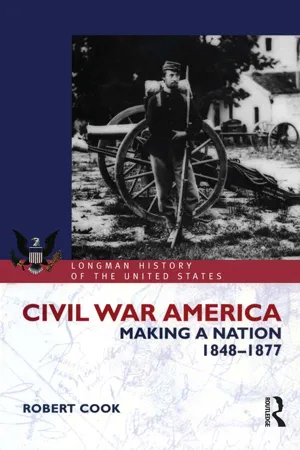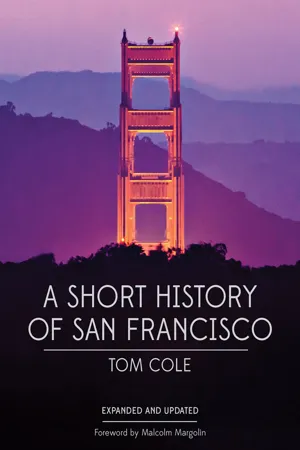History
California Gold Rush
The California Gold Rush was a significant event in American history that began in 1848 when gold was discovered at Sutter's Mill. This discovery led to a massive influx of people from around the world seeking their fortunes, resulting in a population boom in California and significant economic growth for the region. The Gold Rush had a lasting impact on the development of California and the United States.
Written by Perlego with AI-assistance
Related key terms
3 Key excerpts on "California Gold Rush"
- eBook - ePub
- Dennis O. Flynn, Lionel Frost, A. J. H. Latham(Authors)
- 2002(Publication Date)
- Routledge(Publisher)
California and Australia, 1848–57James Gerber
Introduction
Gold was discovered in California on January 24, 1848. The region was technically a part of Mexico at the time, but 18 months earlier U.S. naval forces had seized the regional capital of Monterey from an overextended Mexican empire. Nine days after the discovery, the U.S. and Mexico signed the Treaty of Guadalupe Hidalgo, ceding California and much of the Far West to the United States. The discovery was both confirmed and publicized on December 5, 1848, by President Polk. The ensuing rush to the gold fields turned the territory of California into an American state and the town of San Francisco into one of the busiest commercial centers in the United States.The contours of this resource boom are well known; what is less well appreciated, at least in the U.S., is that a similar discovery occurred three years later in the British colonies of New South Wales and Victoria. Equal in magnitude, the discovery in the British colonies was the result of efforts by Australian prospectors who returned home empty handed after failing to find riches in the California gold fields, only to strike it rich in their homeland.This was not the only connection between the two mining booms, neither was it necessarily the most important. California’s boom resulted in significant growth and development of the regional agricultural economy; so much so, that the state became one of the most important grain-producing regions in the U.S. during the second half of the 19th century. Given the difficulties facing farmers in the form of distances to markets, unfamiliar soils and climates, and labor scarcity generated by the gold-mining boom, the growth of export agriculture into a major supplier of world grain markets was remarkable. The discovery in 1851 of gold in the British colonies of Victoria and New South Wales turned out to be critical to California’s agricultural development. From 1854 to 1860, the important initial years of expansion of grain exports, the high level of demand created by the Australian mining boom provided a relatively protected outlet for California’s surplus production. - eBook - ePub
Civil War America
Making a Nation, 1848-1877
- Robert Cook(Author)
- 2014(Publication Date)
- Routledge(Publisher)
The prospect of untold riches for the many ended in the space of a few years. The first to lose out were Hispanics who were swiftly expelled from the mining camps by whites who had no intention of sharing the anticipated bounty with those they held to be of inferior racial stock. US military officials and the new California legislature aided the process of expulsion with nativist orders and legislation, but the white ‘Argonauts’ themselves were soon casualties of basic geological conditions and economic trends. Most of the gold lay beneath the surface of the earth. To reach it required the sinking of shafts, the use of environmentally destructive hydraulic mining, and the crushing and processing of vast quantities of rock quartz. To do this required skill, technology, and capital – assets which the average miner simply did not possess. As early as the mid-1850s California mining had become a sophisticated industry – the prosaic preserve of urban banks, mining companies, and wage laborers rather than a mecca for the independent citizen of the Republic.Although the majority of white miners did not attain their goals in the high Sierras, they fared better as a group than the existing inhabitants of California whom they helped to displace. The old Mexican elite, large ‘rancheros’ in the main, made some initial gains by furnishing beef to the Argonauts. However, the failure of the Treaty of Guadalupe Hidalgo to guarantee their property rights resulted in an expensive litigation process that left most of them greatly reduced in land and status. Even harder hit were the local Indians, particularly in the northern part of the state where they were hunted down systematically by white settlers. In combination with pandemic Eurasian diseases, the genocidal activity of professional Indian killers like H i Good and Robert Anderson reduced a native population of roughly 150,000 in 1848 to just 30,000 in 1870.6From the perspective of regional and national development, the dark side of the California Gold Rush evinced by these figures was counterbalanced by the event’s contribution to American economic growth. During the early 1850s the United States contributed 45 percent of the total world production of gold. Notwithstanding the onset of economic recession in the middle of the decade, California boomed as interior towns such as Stockton and Sacramento grew up to service the local mining economy and as commercial agriculture spread into the fertile Central Valley (see Map 7 - eBook - ePub
- Tom Cole(Author)
- 2012(Publication Date)
- Heyday(Publisher)
Un an sur les bords du San Joaquin et du Sacramento . Even Heinrich Schliemann came to California, took American citizenship, and later wrote of his experiences (which included making the fortune that bankrolled his successful expeditions in search of the lost city of Troy).Not every observer was edified by the migration to the American El Dorado. Thomas De Quincey, author of Confessions of an English Opium-Eater , compared the Gold Rush to the Children’s Crusade and called it “a swindle…a regular conspiracy of jobbers.” And Henry David Thoreau was appalled. “It makes God to be a moneyed gentleman,” he wrote, “who scatters a handful of pennies in order to see mankind scramble for them. Going to California. It is only three thousand miles closer to hell.”However far from hell it was, the Gold Rush quickly became folklore. And why not? The elements that made up the story were inescapably romantic: courageous, ambitious young men pitted against a remote wilderness, making and losing fortunes, building a wonderful and beautiful city, all against the fascinating backdrop of gold.In later years, writers like Mark Twain and Bret Harte took the complex reality of the Gold Rush and fashioned a tidy and enduring myth. Harte, especially (though he came late to the almost worked-out diggings), created a romantic, comic picture of Gold Rush life. His stories were peopled by golden-hearted prostitutes, cynical gamblers capable of noble self-sacrifice, as in “The Outcasts of Poker Flat,” and rough-hewn miners cooing over orphaned babies, as in his most famous story, “The Luck of Roaring Camp.”It made for a good story, and much of it had a rich vein of truth. But the Gold Rush had another side to it. There was too much money floating around the Mother Lode for theft and mayhem to be absent. “Yesterday one American shot another in the street and the occurrence was not noticed as much as a dog fight back home,” wrote one visitor. Louise Clapp, one of the few fine-grained ladies in the hills, described life in the diggings in a series of letters to her sister back East, letters that became famous as “The Shirley Letters” when published in San Francisco. “In one short space of twenty-four hours,” she wrote, “we have had murders, fearful accidents, bloody deaths, a mob, whippings, a hanging, an attempt at suicide and a fatal duel.” That was surely an extraordinary twenty-four hours (and all those carryings-on were part of a single skein of violence), but the diggings were clearly no place for the faint of heart.
Learn about this page
Index pages curate the most relevant extracts from our library of academic textbooks. They’ve been created using an in-house natural language model (NLM), each adding context and meaning to key research topics.


